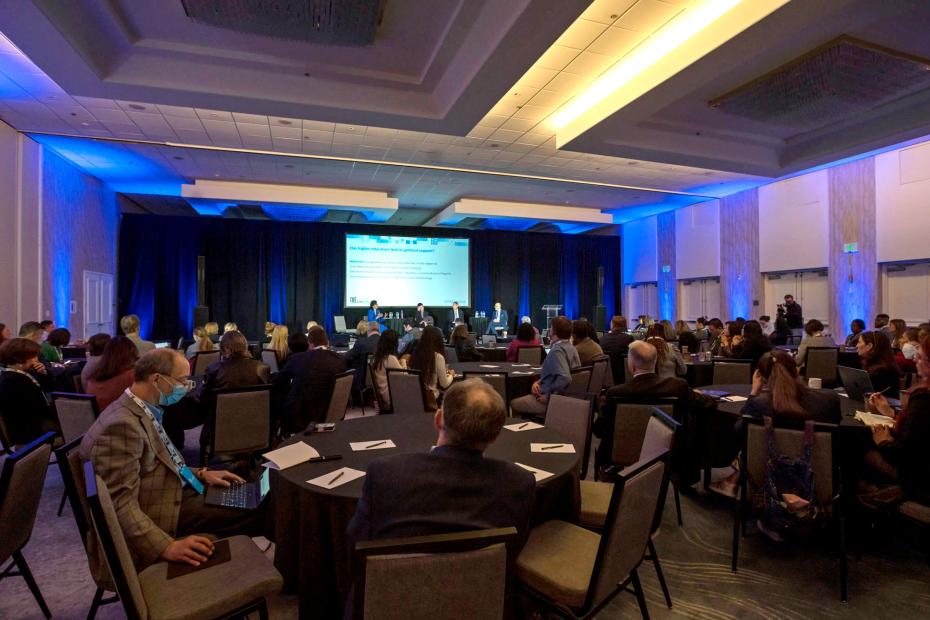
Why university-wide curriculum transformation is a leap of faith

Teaching excellence and student outcomes are measurable and meaningful differentiators in our increasingly competitive sector. As a comparatively small university, we rank highly in these areas, as our triple-gold Teaching Excellence Framework and National Student Survey scores reflect. But sustaining this success is not easy.
In 2018, our student numbers were growing, the sector was changing and so were the needs of employers. Our 20-year-old education framework and dated technologies and approaches were holding us back. Courses had proliferated organically into crowded curricula with a lot of assessment and related stress for students.
We came to the hard realisation that we had to overhaul our entire education curriculum – redesigning all our undergraduate (UG) and postgraduate taught (PGT) courses, assessment and teaching methods – to streamline and enrich the learning experience and better equip our students for the evolving modern workplace.
- Read more: back to the basics of pedagogy
- Campus podcast: how to lead a university from the front
- Lessons from developing a whole-university well-being strategy
It would be a true curriculum transformation (CT), with course-wide design yielding longer, team-taught units that connect topics and build on learning for deeper and more holistic subject knowledge. Practical exercises and team projects apply what is learned and foster transferable skills. New teaching technologies and methods enhance accessibility and engagement. For consistency, cost and outcomes, CT had to be a simultaneous, silo-busting, whole-course, whole-university innovation initiative.
Now, as we enter our second year of full CT course implementation, we’re sharing insights and advice for those embarking on their own CT journeys.
Define your goals and prepare to measure them
To guide our transformation, we agreed clear goals founded on what we heard from stakeholders, including students, staff, industry partners and accreditation bodies, through surveys, discussions and discovery workshops. These were:
- To improve visibility and understanding of our whole education portfolio
- To take a strategic, holistic approach to course development, centred on well-grounded principles for the curriculum, and building on our strengths
- To move towards a culture of continuous improvement to sustain our reputation in education.
Key advice
Set your goals and think about how you’ll evaluate success. Then capture metrics before you start for comparison later. Consider in-course student surveys for early feedback.
Resource your project effectively
The scale of change and effort made our CT an epic undertaking that required strategic investment and careful resourcing. Having inspiring people to initiate the project and a passionate and diverse team to reignite and drive it, after a pandemic-enforced hiatus, were both critical to our success.
New teaching approaches required technical support and different space needs, and CT affected systems, academic registry, student support and many other departments.
Our cross-discipline project-steering team was the first of its kind at the university, and a small dynamic project team provided coordination and troubleshooting.
To improve the visibility of our education portfolio, we created a single source of truth and a system for approval and monitoring material course data on our student information system (SITS).
We had to budget for additional resource to make more than 500,000 system data changes and to support faculties with a range of new needs.
Key advice
Build the right mix of personalities and specialisms to drive your project and support academics. Be prepared and resourced for extra work and significant changes to course data.
Create shared course-design principles
Though central support was provided, we found most course innovation happened in academic departments. To ensure consistent, holistic transformation – where course content builds on what was learned before rather than merging units into longer ones – we co-created course-design principles.
We began with 15, but four emerged as core, against which we evaluate CT course quality. They are:
- Articulate a course-wide approach to learning
- Embrace assessment for learning
- Support the diverse needs of learners
- Embed citizenship and sustainability.
Key advice
Define a set of common course-design principles that encapsulate your learning goals but allow flexibility for the diverse needs of different specialisms.
Consult and collaborate widely with stakeholders
With employability and quality of the learning experience as key student outcomes, we engaged with industry partners, potential employers, students, staff, external reviewers and accreditation bodies in designing our new courses.
Key advice
Define your target outcomes and consult relevant stakeholders on how best to achieve them.
Test the water
We piloted our ideas with early-adopter and vanguard courses…and then Covid-19 hit. The pioneering teams and the pandemic both yielded insights and highlighted the enhanced agility and resilience of new teaching delivery methods.
Early gains were encouraging, including a 34 per cent reduction in assessment time in chemical engineering and 89 per cent overall satisfaction from students in architecture and civil engineering vanguard courses.
Key advice
Harness the enthusiasm and courage of early adopters to test your principles and hone approaches.
Knock-on issues and benefits
Implementing a step change in course design has its challenges, such as student suspensions that involve rejoining on a transformed course. Combined units require collaborative design, team teaching and equitable assessment, which took adjustment for lecturers used to working alone.
CT can expose and catalyse perennial issues, such as teaching space, technology and timetabling.
CT also made it possible to embed institutional themes into the curriculum, such as sustainability, and emerging technologies, such as generative AI.
Key advice
Explore potential impacts and opportunities and brainstorm solutions with a cross-discipline team.
Sustain momentum
To sustain the benefits of CT, we are working to embed a spirit of continuous enhancement in line with our course-design principles. We hope this will be fostered by pedagogical benefits that we are already seeing, such as increased collaboration, course-wide thinking, employability focus and team teaching.
Key advice
Plan transition to business as usual carefully to avoid reversion to pre-CT complacency.
A leap into the future
For us, CT has been an evolutionary leap and a vital investment in our future to keep us at the forefront of the sector and continue to make Bath the place to be for students and staff from around the world.
Marion Harney is associate dean for education in the Faculty of Engineering and Design, and is leading the institutional curriculum transformation project; Julian Chaudhuri is pro vice-chancellor (education & global); both are at the University of Bath.
If you would like advice and insight from academics and university staff delivered direct to your inbox each week, sign up for the Campus newsletter.


